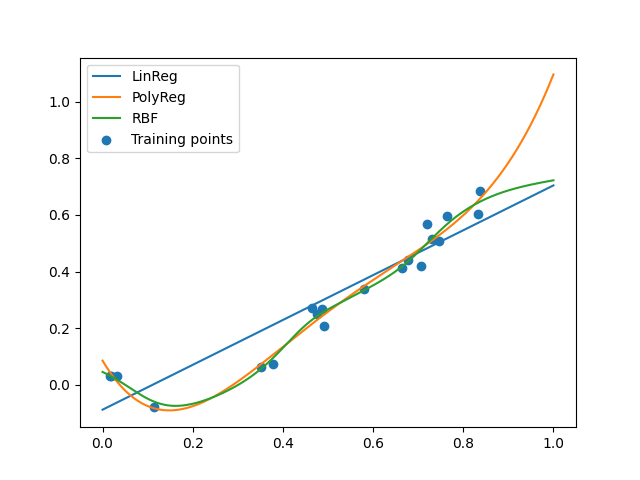Note
Go to the end to download the full example code
Machine learning algorithm selection example¶
In this example we use the MLAlgoSelection class to perform a grid
search over different algorithms and hyperparameter values.
from __future__ import annotations
import matplotlib.pyplot as plt
from numpy import linspace
from numpy import sort
from numpy.random import default_rng
from gemseo.algos.design_space import DesignSpace
from gemseo.datasets.io_dataset import IODataset
from gemseo.mlearning.core.selection import MLAlgoSelection
from gemseo.mlearning.quality_measures.mse_measure import MSEMeasure
rng = default_rng(54321)
Build dataset¶
The data are generated from the function \(f(x)=x^2\). The input data \(\{x_i\}_{i=1,\cdots,20}\) are chosen at random over the interval \([0,1]\). The output value \(y_i = f(x_i) + \varepsilon_i\) corresponds to the evaluation of \(f\) at \(x_i\) corrupted by a Gaussian noise \(\varepsilon_i\) with zero mean and standard deviation \(\sigma=0.05\).
n = 20
x = sort(rng.random(n))
y = x**2 + rng.normal(0, 0.05, n)
dataset = IODataset()
dataset.add_variable("x", x[:, None], dataset.INPUT_GROUP)
dataset.add_variable("y", y[:, None], dataset.OUTPUT_GROUP)
Build selector¶
We consider three regression models, with different possible hyperparameters. A mean squared error quality measure is used with a k-folds cross validation scheme (5 folds).
selector = MLAlgoSelection(
dataset, MSEMeasure, measure_evaluation_method_name="KFOLDS", n_folds=5
)
selector.add_candidate(
"LinearRegressor",
penalty_level=[0, 0.1, 1, 10, 20],
l2_penalty_ratio=[0, 0.5, 1],
fit_intercept=[True],
)
selector.add_candidate(
"PolynomialRegressor",
degree=[2, 3, 4, 10],
penalty_level=[0, 0.1, 1, 10],
l2_penalty_ratio=[1],
fit_intercept=[True, False],
)
rbf_space = DesignSpace()
rbf_space.add_variable("epsilon", 1, "float", 0.01, 0.1, 0.05)
selector.add_candidate(
"RBFRegressor",
calib_space=rbf_space,
calib_algo={"algo": "fullfact", "n_samples": 16},
smooth=[0, 0.01, 0.1, 1, 10, 100],
)
Select best candidate¶
best_algo = selector.select()
best_algo
Plot results¶
Plot the best models from each candidate algorithm
finex = linspace(0, 1, 1000)
for candidate in selector.candidates:
algo = candidate[0]
print(algo)
predy = algo.predict(finex[:, None])[:, 0]
plt.plot(finex, predy, label=algo.SHORT_ALGO_NAME)
plt.scatter(x, y, label="Training points")
plt.legend()
plt.show()

LinearRegressor(fit_intercept=True, l2_penalty_ratio=0, penalty_level=0, random_state=0)
based on the scikit-learn library
built from 20 learning samples
PolynomialRegressor(degree=4, fit_intercept=True, l2_penalty_ratio=1, penalty_level=0, random_state=0)
based on the scikit-learn library
built from 20 learning samples
RBFRegressor(epsilon=0.1, function=multiquadric, norm=euclidean, smooth=0.1)
based on the SciPy library
built from 20 learning samples
Total running time of the script: (0 minutes 3.821 seconds)
